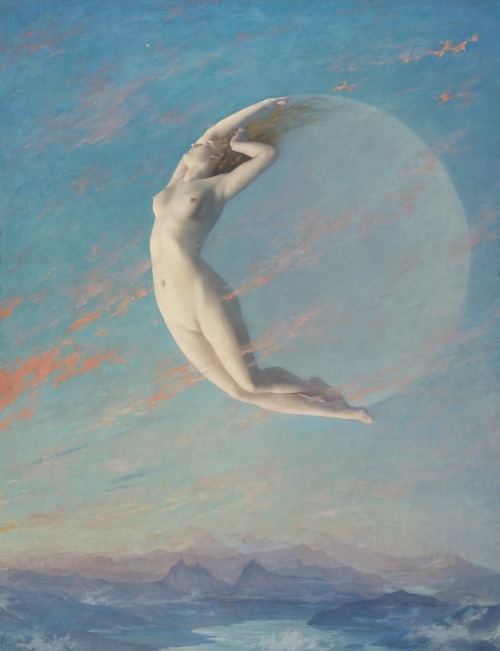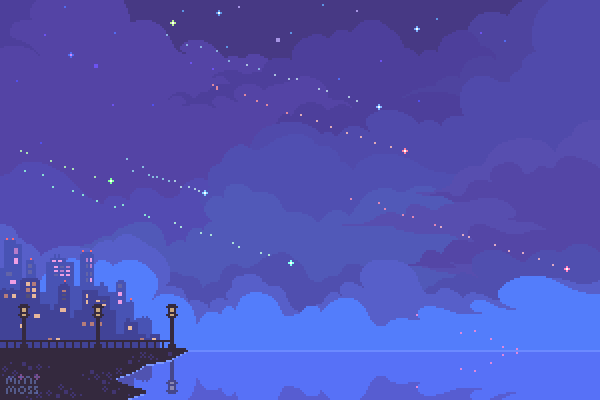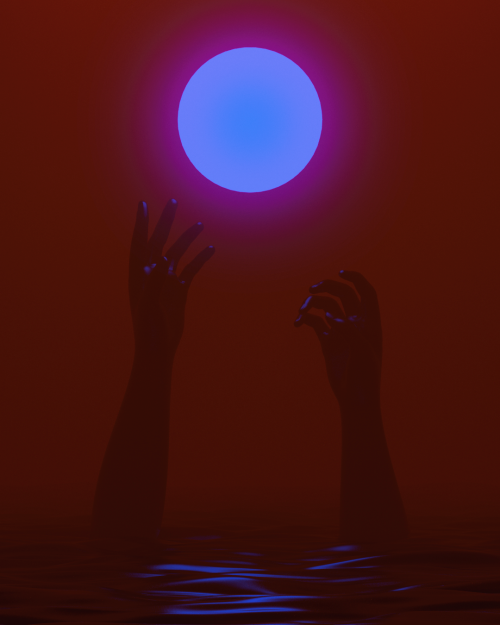“Nebulose Diffuse, Semplici, Stellate. Cometa. Pianeti. Anelli.” (to Accompany) Atlante Di Geografia

“Nebulose diffuse, semplici, stellate. cometa. pianeti. anelli.” (to accompany) Atlante di geografia universale. 1842.
David Rumsey
More Posts from Cozy-airlessness and Others

The first test flight of the Apollo Lunar Module in Earth orbit launched from Cape Kennedy launch complex 37B aboard Saturn IB SA-204R on January 22, 1968.

Here, we see LM-1 being loaded into the spacecraft adapter that would protect it during launch. The nose cone (at right, under a protective blue cover) would go on top.
The unmanned LM-1 flew without several systems (like landing gear) that it wouldn't need for the test and the windows in front were covered with aluminum plates. After testing of the descent and ascent stage engines, the two sections of LM-1 burned up in the atmosphere on re-entry.



Selene
Albert Aublet / Jules Louis Machard

Southern moonscape



Space looks very different to how film and television might show. Lots of sci-fi shows or movies portray the stars and galaxy behind a planet, and while it can look pretty, it also is very unrealistic. Stars are very dim. The galaxy is even dimmer. Anybody that lives in a light-pollluted area knows these things. Sunlight, and the light from it that shines onto the planets, is very very bright. This is why you can’t see stars during the day time. You can turn the exposure of your camera up to see both the planet and the stars, but then the planet becomes blindingly bright, and you get lots of camera glare.
Images taken using Space Engine 0.990.37.1720
Unrelated spiritual stuff below
This post probably sounds like nitpicking, and I guess it is. I’m not sure if I like the spirit of space being tampered with just to make things look better in a blockbuster movie. I believe the darkness and quietness is what contains the energy of space, and that feature of it is sacred. Space to me is an ocean, and filling space with clouds/nebulae and planets in a fictional setting feels a lot like completely filling the oceans with seaweed and sand. Planets are extremely far apart, and that is a blessing, as otherwise they would collide with each other. I don’t really have any personal grudges on people that exaggerate space for visual or story related reasons, I think it’s more of a cultural issue, and one that will be resolved over enough time as life on Earth begins to wander into space.

The Long Gas Tail of Spiral Galaxy D100 : Why is there long red streak attached to this galaxy? The streak is made mostly of glowing hydrogen that has been systematically stripped away as the galaxy moved through the ambient hot gas in a cluster of galaxies. Specifically, the galaxy is spiral galaxy D100, and cluster is the Coma Cluster of galaxies. The red path connects to the center of D100 because the outer gas, gravitationally held less strongly, has already been stripped away by ram pressure. The extended gas tail is about 200,000 light-years long, contains about 400,000 times the mass of our Sun, and stars are forming within it. Galaxy D99, visible to D100’s lower left, appears red because it glows primarily from the light of old red stars – young blue stars can no longer form because D99 has been stripped of its star-forming gas. The featured false-color picture is a digitally enhanced composite of images from Earth-orbiting Hubble and the ground-based Subaru telescope. Studying remarkable systems like this bolsters our understanding of how galaxies evolve in clusters. via NASA

Train 🌟
Twitter | Instagram | Deviantart

S.2.186
instagram: @fesq.project





MOLLY COBB in For All Mankind (2019– )
This is a new sideblog of mine




Small Earth render pack
Also featuring Luna!
Made using the Steam version of SpaceEngine. Feel free to use without credit, but crediting the SpaceEngine team is courteous!
-
 colorfulmilkshakestrawberry liked this · 4 weeks ago
colorfulmilkshakestrawberry liked this · 4 weeks ago -
 space-moon-night reblogged this · 2 months ago
space-moon-night reblogged this · 2 months ago -
 koalatattoo liked this · 2 months ago
koalatattoo liked this · 2 months ago -
 wildflowerdaysi liked this · 6 months ago
wildflowerdaysi liked this · 6 months ago -
 farmwitch liked this · 1 year ago
farmwitch liked this · 1 year ago -
 et-iterum liked this · 2 years ago
et-iterum liked this · 2 years ago -
 92till liked this · 3 years ago
92till liked this · 3 years ago -
 theyounggodlives reblogged this · 3 years ago
theyounggodlives reblogged this · 3 years ago -
 elsabetindustries liked this · 3 years ago
elsabetindustries liked this · 3 years ago -
 red-neon liked this · 3 years ago
red-neon liked this · 3 years ago -
 eusoupoeiraestelar liked this · 3 years ago
eusoupoeiraestelar liked this · 3 years ago -
 blackheroin70s reblogged this · 3 years ago
blackheroin70s reblogged this · 3 years ago -
 sillyloversoul liked this · 3 years ago
sillyloversoul liked this · 3 years ago -
 venusou reblogged this · 3 years ago
venusou reblogged this · 3 years ago -
 artfeatherkaas-blog liked this · 3 years ago
artfeatherkaas-blog liked this · 3 years ago -
 digitaloves reblogged this · 3 years ago
digitaloves reblogged this · 3 years ago -
 ohwhatdidisay reblogged this · 3 years ago
ohwhatdidisay reblogged this · 3 years ago -
 boxcaroscar liked this · 3 years ago
boxcaroscar liked this · 3 years ago -
 moonofiron liked this · 3 years ago
moonofiron liked this · 3 years ago -
 issa-n reblogged this · 3 years ago
issa-n reblogged this · 3 years ago -
 drdeeath liked this · 4 years ago
drdeeath liked this · 4 years ago -
 desentegraivos liked this · 4 years ago
desentegraivos liked this · 4 years ago -
 valleleitura liked this · 4 years ago
valleleitura liked this · 4 years ago -
 comamoruniverso liked this · 4 years ago
comamoruniverso liked this · 4 years ago -
 sierennn liked this · 4 years ago
sierennn liked this · 4 years ago -
 marcoscruzus liked this · 4 years ago
marcoscruzus liked this · 4 years ago -
 palavras-ruins-de-uma-linda-boca liked this · 4 years ago
palavras-ruins-de-uma-linda-boca liked this · 4 years ago -
 anjinho-barroco liked this · 4 years ago
anjinho-barroco liked this · 4 years ago -
 the-sprigam liked this · 4 years ago
the-sprigam liked this · 4 years ago -
 babyimasweetserialkiller reblogged this · 4 years ago
babyimasweetserialkiller reblogged this · 4 years ago -
 neptuneinjuly liked this · 4 years ago
neptuneinjuly liked this · 4 years ago -
 voilamonamour liked this · 4 years ago
voilamonamour liked this · 4 years ago -
 theageofambivalence liked this · 4 years ago
theageofambivalence liked this · 4 years ago -
 womaninterrupted liked this · 4 years ago
womaninterrupted liked this · 4 years ago -
 katoprofen liked this · 4 years ago
katoprofen liked this · 4 years ago -
 fractal-heartbeats reblogged this · 4 years ago
fractal-heartbeats reblogged this · 4 years ago -
 milky-dreamer liked this · 4 years ago
milky-dreamer liked this · 4 years ago -
 halimahmariee liked this · 4 years ago
halimahmariee liked this · 4 years ago -
 kennnykens reblogged this · 4 years ago
kennnykens reblogged this · 4 years ago -
 blessxhardy reblogged this · 4 years ago
blessxhardy reblogged this · 4 years ago -
 blessxhardy liked this · 4 years ago
blessxhardy liked this · 4 years ago

21 · female · diagnosed asperger'sThe vacuum of outer space feels so comfy :)
233 posts